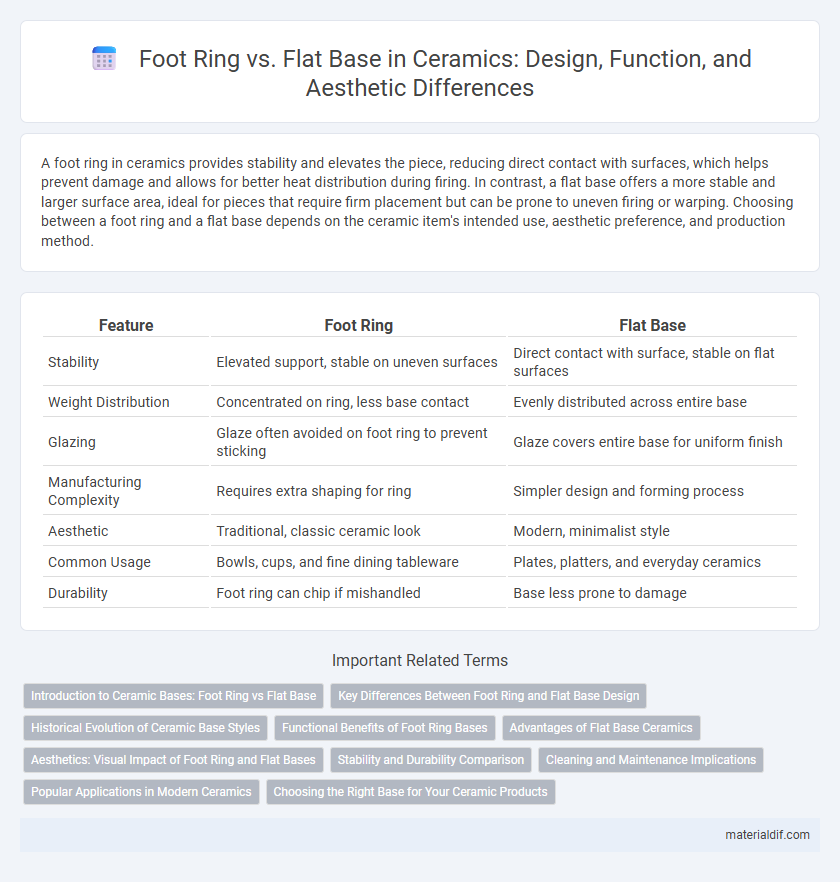A foot ring in ceramics provides stability and elevates the piece, reducing direct contact with surfaces, which helps prevent damage and allows for better heat distribution during firing. In contrast, a flat base offers a more stable and larger surface area, ideal for pieces that require firm placement but can be prone to uneven firing or warping. Choosing between a foot ring and a flat base depends on the ceramic item's intended use, aesthetic preference, and production method.
Table of Comparison
| Feature | Foot Ring | Flat Base |
|---|---|---|
| Stability | Elevated support, stable on uneven surfaces | Direct contact with surface, stable on flat surfaces |
| Weight Distribution | Concentrated on ring, less base contact | Evenly distributed across entire base |
| Glazing | Glaze often avoided on foot ring to prevent sticking | Glaze covers entire base for uniform finish |
| Manufacturing Complexity | Requires extra shaping for ring | Simpler design and forming process |
| Aesthetic | Traditional, classic ceramic look | Modern, minimalist style |
| Common Usage | Bowls, cups, and fine dining tableware | Plates, platters, and everyday ceramics |
| Durability | Foot ring can chip if mishandled | Base less prone to damage |
Introduction to Ceramic Bases: Foot Ring vs Flat Base
Ceramic bases exhibit two primary forms: foot ring and flat base, each influencing stability and aesthetic appeal. The foot ring elevates the piece slightly, providing a traditional look and allowing airflow beneath, which aids in kiln firing and reduces surface contact. Flat bases offer a modern, streamlined appearance with maximum surface contact, enhancing stability on flat surfaces and simplifying stacking during storage.
Key Differences Between Foot Ring and Flat Base Design
Foot ring designs elevate ceramic pieces by creating a raised, circular base that enhances stability and reduces surface contact, ideal for items like bowls or cups requiring precise balance. Flat base designs feature a smooth, continuous bottom, providing maximum surface contact for sturdiness and ease of stacking, commonly used in plates and flatware. The key differences lie in their structural impact on stability, aesthetic appeal, and functional usability within ceramic craftsmanship.
Historical Evolution of Ceramic Base Styles
The historical evolution of ceramic base styles reveals a transition from foot rings, prevalent in ancient and traditional pottery for stability and stacking, to flat bases favored in modern ceramics for enhanced surface contact and aesthetic simplicity. Foot rings originated in East Asian ceramics, particularly during the Tang and Song Dynasties, serving functional and decorative purposes, while flat bases gained prominence in European porcelain from the 18th century onward, reflecting changes in production techniques and consumer preferences. This shift highlights the interplay between cultural influences, technological advancements, and evolving artistic trends in ceramic craftsmanship.
Functional Benefits of Foot Ring Bases
Foot ring bases in ceramics offer enhanced stability by elevating the piece, reducing direct contact with surfaces and minimizing the risk of scratching or heat damage. This design also improves airflow under the piece, aiding in faster drying and even heat distribution during firing. Compared to flat bases, foot ring bases provide ergonomic handling benefits, making them easier to lift and maneuver without compromising structural integrity.
Advantages of Flat Base Ceramics
Flat base ceramics offer enhanced stability and balance compared to foot ring designs, reducing the risk of tipping and providing a sturdier foundation for various pottery pieces. The flat base also allows for easier glazing and finishing processes, ensuring a smooth, even surface free from imperfections commonly found around foot rings. This design is particularly advantageous in modern ceramic production, where efficiency and uniformity are critical for mass manufacturing and functional use.
Aesthetics: Visual Impact of Foot Ring and Flat Bases
Foot rings create a distinct shadow and lift the ceramic piece, adding depth and enhancing visual appeal, while flat bases offer a clean, minimalist look that emphasizes simplicity and stability. The elevated profile of foot rings can highlight craftsmanship and elegance, making them ideal for decorative ceramics, whereas flat bases provide a modern aesthetic suited for functional ware. Choosing between foot ring and flat base affects the overall balance and presence of ceramics in both display and use.
Stability and Durability Comparison
Foot rings in ceramics provide enhanced stability by elevating the piece slightly, minimizing direct contact with surfaces and reducing the risk of wobbling. Flat bases offer broader contact areas that distribute weight evenly, improving durability against cracking or chipping under pressure. Choosing between foot ring and flat base depends on balancing the need for stability in display with long-term durability during usage.
Cleaning and Maintenance Implications
Foot rings on ceramics create elevated surfaces that reduce contact with tables, minimizing residue accumulation and making cleaning easier by allowing better access to the base. Flat bases, however, tend to trap more dirt and moisture underneath, requiring more thorough scrubbing and drying to prevent stains and damage. Choosing foot ring designs enhances maintenance efficiency by promoting airflow and reducing prolonged exposure to grime.
Popular Applications in Modern Ceramics
Foot rings are commonly used in wheel-thrown pottery, providing stability and a distinct aesthetic, especially in functional tableware like bowls and cups. Flat bases dominate in slip-cast ceramics, often favored for mass-produced items such as plates and decorative tiles, offering ease in stacking and uniformity. Both foot rings and flat bases are integral in contemporary ceramic design, balancing practicality with stylistic preferences across various crafting techniques.
Choosing the Right Base for Your Ceramic Products
Selecting the right base for ceramic products significantly impacts their stability and aesthetic appeal. Foot rings provide elevation and enhance air circulation during firing, ideal for functional pottery like bowls and cups, while flat bases offer a modern look and are easier to clean, suitable for plates and decorative items. Understanding the role of each base type ensures better durability and customer satisfaction in ceramic design.
Foot Ring vs Flat Base Infographic

 materialdif.com
materialdif.com